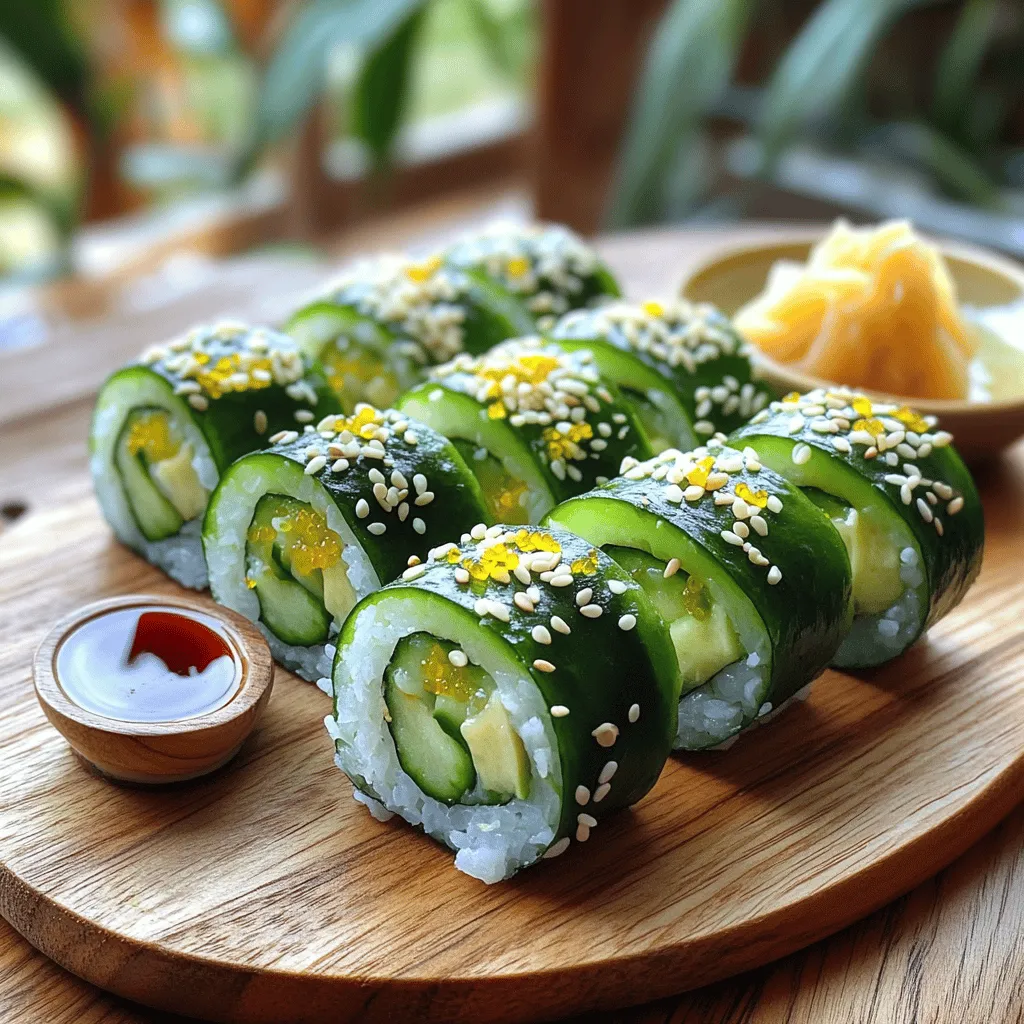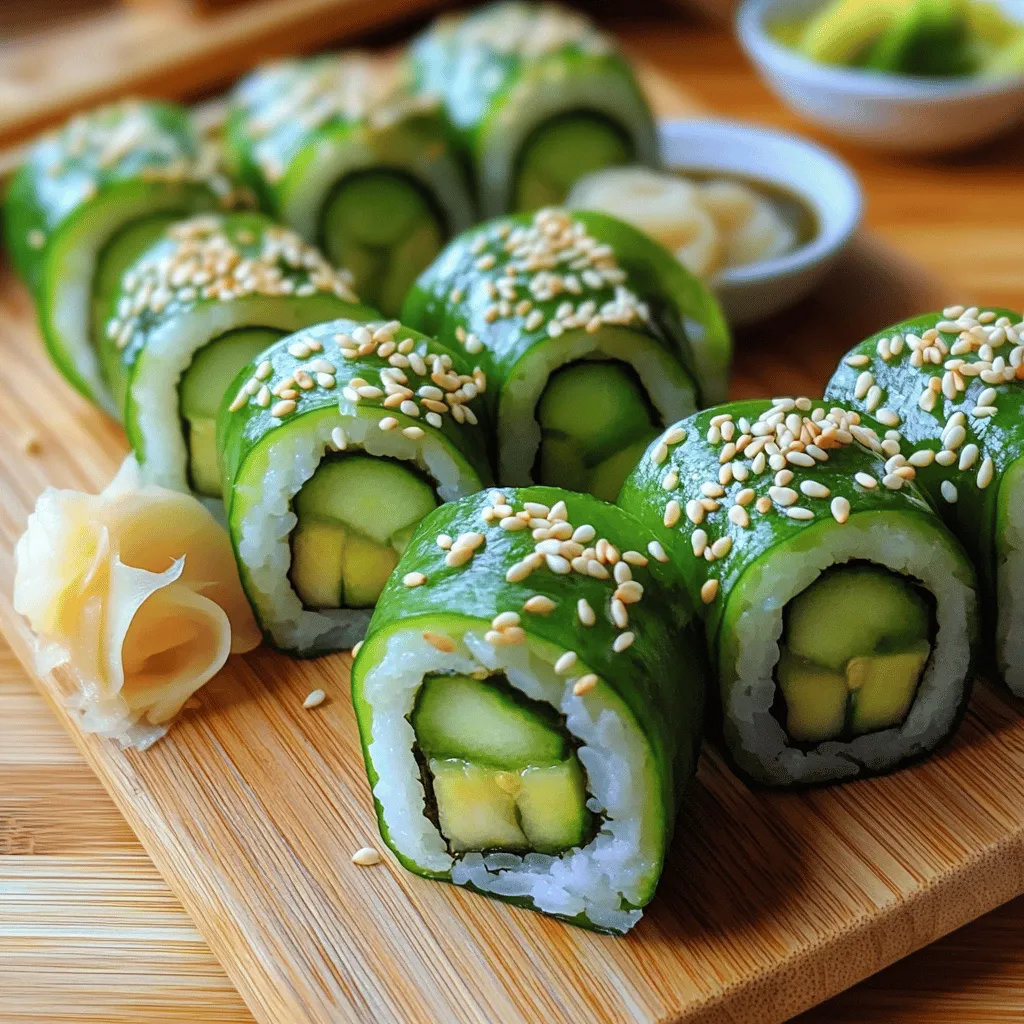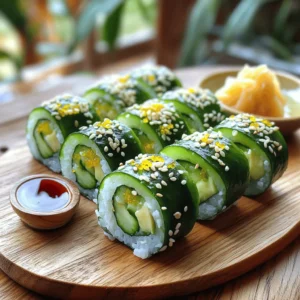Cucumber Avocado Sushi Rolls Fresh and Flavorful Dish

Ready to dive into making Cucumber Avocado Sushi Rolls? This fresh and flavorful dish is not only easy to prepare but also packed with vibrant ingredients. With simple steps, you can create delicate sushi rolls that impress anyone at your table. Join me as I share the essential ingredients, preparation tips, and creative variations that will elevate your sushi experience. Let’s roll into this tasty adventure together!
Ingredients
Detailed Ingredient List
– 1 cup sushi rice
– 1 1/4 cups water
– 2 tablespoons rice vinegar
– 1 tablespoon sugar
– 1 teaspoon salt
– 4 sheets nori (seaweed)
– 1 medium cucumber, julienned
– 1 ripe avocado, sliced
– 1 medium carrot, julienned
– 1 tablespoon sesame seeds (optional)
– Soy sauce, for dipping
– Wasabi and pickled ginger, for serving
When I make cucumber avocado sushi rolls, I always start with sushi rice. The rice is vital for the roll’s texture. I rinse it well under cold water. This helps remove extra starch. I want the rice to be fluffy and not sticky.
Next, I cook the rice. I use a pot with a lid. I add the rinsed rice to water and bring it to a boil. Then, I lower the heat and cover it. It simmers for 18-20 minutes. After cooking, I let it steam for another 10 minutes. This step is key to fluffy rice.
While the rice rests, I prepare the seasoning. I mix rice vinegar, sugar, and salt in a small bowl. I whisk until it dissolves. Once the rice cools, I fold this mix in. This gives the rice a nice flavor.
For the filling, I choose fresh vegetables. I julienne cucumber and carrot and slice the avocado. These add crunch and creaminess. Sometimes, I sprinkle sesame seeds on top for extra taste.
I also need nori sheets for wrapping. These sheets hold everything together. Finally, I have soy sauce, wasabi, and pickled ginger ready for dipping. These condiments enhance the sushi’s flavor.
This is what makes cucumber avocado sushi rolls so fresh and tasty. You can find the full recipe in the recipe section above.
Step-by-Step Instructions
Preparation of Sushi Rice
How do I rinse sushi rice?
First, place the sushi rice in a bowl. Rinse the rice under cold water. Swirl it gently until the water turns clear. This step is key. It removes extra starch.
What is the cooking method and timing?
Combine the rinsed rice with 1 1/4 cups of water in a pot. Bring it to a boil over medium-high heat. Once boiling, lower the heat. Cover and simmer for 18-20 minutes. After the water is gone, turn off the heat and let it sit, covered, for 10 more minutes. This steams the rice.
How do I season the rice?
While the rice rests, mix rice vinegar, sugar, and salt in a bowl. Whisk until dissolved. Once the rice has cooled, fold this mixture into it gently. Spread the rice on a plate or tray to cool faster.
Assembling the Sushi Rolls
How do I set up the sushi mat and nori?
Place a bamboo sushi mat on a clean surface. Lay a sheet of nori on the mat, shiny side down. This helps the rice stick.
How do I spread the rice?
Wet your hands to prevent sticking. Take a small handful of sushi rice. Spread it evenly over the nori, leaving about 1 inch at the top. Aim for a thin layer.
How do I add fillings and roll?
In the center of the rice, place a line of julienned cucumber, avocado slices, and julienned carrot. If you like, sprinkle sesame seeds on top. To roll, lift the edge of the mat closest to you. Tuck the filling tightly as you roll towards the uncovered edge. Moisten this edge with water to seal the roll.
Final Steps
How do I slice the sushi rolls?
Once your rolls are ready, take a sharp knife. Slice each roll into bite-sized pieces. Wipe the knife with a damp cloth between cuts for clean edges.
What are some serving suggestions and presentation tips?
Arrange the sushi on a platter. Serve with soy sauce, wasabi, and pickled ginger. For a stunning look, use a wooden board. Garnish with sesame seeds and green onions. This adds color and flair to your dish. For the full recipe, check the earlier section.
Tips & Tricks
Ensuring Perfect Sushi Rice
To make great sushi, you need perfect rice. Rinsing sushi rice is the first step. Rinse it until the water runs clear. This removes excess starch. If you skip this, your rice may turn gummy.
Next, cook the rice properly. Use 1 1/4 cups of water for every cup of rice. Bring it to a boil, then lower the heat. Cover and let it simmer for 18 to 20 minutes. After cooking, let it sit for 10 minutes. This steaming helps the rice fluff up nicely.
Seasoning is key. Mix rice vinegar, sugar, and salt until dissolved. Gently fold this into the rice. This step adds flavor and makes the rice sticky, perfect for rolling.
Rolling Techniques
Rolling sushi takes practice. Start by using the right pressure. When you roll, don’t press too hard. This can squish the filling out. Instead, apply even pressure as you roll.
Keep the roll tight. If it’s loose, the sushi may fall apart later. Use a bamboo mat to help. Tuck the nori over the filling and keep rolling. Seal the edge with a little water to hold everything together.
Serving Suggestions
How you serve sushi matters. Try unique ways to present your rolls. Use a wooden board for a rustic look. Garnish with sesame seeds and chopped green onions. This adds a pop of color.
Pair your sushi with soy sauce, wasabi, and pickled ginger. These sides enhance the flavors. You can even serve sushi with a side salad for a fresh touch. For more details, check the Full Recipe.

Variations
Different Fillings
You can play with the fillings in your cucumber avocado sushi rolls. Besides cucumber and avocado, try these tasty veggies:
– Bell peppers
– Spinach
– Radish
If you want some protein, consider adding:
– Tofu for a vegan option
– Crab if you enjoy seafood
– Cooked shrimp for a fresh twist
These changes can make each roll unique.
Sauces and Dips
The right sauce can elevate your sushi rolls. Traditional soy sauce works well. However, you might want to try:
– Spicy mayo for a kick
– Teriyaki sauce for sweetness
– Ponzu sauce for a citrus twist
If you like to make your own dips, here are some ideas:
– Mix mayo with sriracha for a creamy dip
– Blend soy sauce with a dash of sesame oil for added flavor
Dietary Adjustments
If you have dietary needs, you can still enjoy these sushi rolls. For gluten-free options, use gluten-free soy sauce.
If you follow a vegan diet, stick with tofu and veggies. Avoid any seafood or animal-based products.
These adjustments ensure everyone can enjoy fresh and flavorful sushi rolls. For the full recipe, check out my guide on cucumber avocado sushi rolls.
Storage Info
Storing Leftover Sushi
To keep your cucumber avocado sushi rolls fresh, store them in an airtight container. This helps prevent them from drying out. You can place a damp paper towel inside to maintain moisture. It is best to eat sushi within 24 hours for the best taste. The sushi can last up to 48 hours in the fridge, but the texture may change.
Reheating Tips
Sushi is best served cold, so reheating is usually not needed. If you want to enjoy it warm, heat the rolls gently in the microwave. Use a low power setting for about 10-15 seconds. Check to see if it warms evenly. Avoid overheating, as this can make the rice tough. Enjoy your sushi the next day for a quick and tasty meal! For more ideas, check out the Full Recipe for more delicious serving suggestions.
FAQs
What is the best rice for sushi?
The best rice for sushi is short-grain sushi rice. This type of rice has a high starch content. It becomes sticky when cooked, which helps the rolls hold together. Look for brands like Koshihikari or Calrose when shopping. These options give a perfect texture for sushi.
Can I make sushi without a bamboo mat?
Yes, you can make sushi without a bamboo mat. If you don’t have one, use a clean kitchen towel. Lay the nori on the towel, then spread the rice on top. Roll it tightly, using your hands to shape it. You can also use a plastic wrap for easier handling.
How do I know if my avocado is ripe?
To check if an avocado is ripe, gently squeeze it. It should feel soft but not mushy. Look for a dark green or black skin color. You can also remove the stem cap; if it’s green underneath, it’s ripe. If it’s brown, wait a few days before using it.
Making sushi at home is easy with the right ingredients and steps. We covered sushi rice, seasoning, and assembling the rolls. Remember to avoid common mistakes in rice preparation and rolling techniques. You can also explore different fillings, sauces, and dietary options to make sushi your own. Lastly, store any leftovers properly to enjoy later. Now, you can confidently create delicious sushi tailored to your taste! Enjoy the process and make it a fun meal for you and your loved ones.



![- 2 ripe avocados - 4 slices whole-grain bread - 1 small clove garlic, finely minced - 1 tablespoon freshly squeezed lemon juice - Sea salt and freshly ground black pepper - 1/4 teaspoon red pepper flakes (optional) - Microgreens or fresh herbs for garnish - 2 tablespoons extra virgin olive oil To make your easy avocado toast shine, gather these fresh ingredients. Ripe avocados are the star. They bring creaminess and flavor. Whole-grain bread gives a hearty base. I love the texture it adds. Garlic enhances the taste, giving a nice kick. For seasoning, lemon juice brightens the dish. It prevents the avocado from browning too. Sea salt and black pepper add a savory touch. If you like a bit of heat, red pepper flakes work great. Don’t forget the finishing touch! Microgreens or herbs bring color and freshness. A drizzle of olive oil adds richness. This simple list helps you create a delicious meal. You can find the full recipe at the end of this section. - Halve and pit the avocados. - Scoop the flesh into a bowl. Start by cutting the avocados in half. Use a spoon to remove the pit. Be careful not to cut yourself. Next, scoop out the soft green flesh into a bowl. Make sure to get all the delicious parts. - Combine garlic, lemon juice, salt, and pepper. - Mash to desired consistency. Now, add the finely minced garlic, lemon juice, salt, and pepper to the bowl. Use a fork to mash everything together. You can make it as smooth or chunky as you like. I prefer a nice creamy texture, but you can choose your favorite. - Toast whole-grain bread to golden brown. While you mash the avocado, toast your whole-grain bread. Keep it in the toaster until it’s golden brown. This step adds crunch and warmth to your dish. - Drizzle olive oil on toast. - Spread avocado mixture generously. Once the bread is done, drizzle some olive oil on top. This adds flavor and richness. Next, spread your mashed avocado on the toast. Don’t be shy—use a generous amount. Enjoy the creaminess and the crunch of the toast together. For the full recipe, check out the detailed instructions. To get the best mash, think about the texture you want. For a creamy blend, use a fork and press down hard. If you prefer chunks, mash less. For tools, a fork works well, but a potato masher gives you a nice, even mash. Serve your avocado toast on a colorful plate or a wooden board. This makes your dish pop! Add a slice of lemon or some extra herbs on the side for a fun look. Bright colors make every bite more inviting. You can add many toppings to boost flavor. Slice fresh tomatoes or sprinkle crumbled feta cheese on top. For a breakfast twist, try a poached egg. Want some heat? Mix in red pepper flakes or a dash of hot sauce. This adds a great kick! For more ideas, check out the Full Recipe. {{image_4}} You can get creative with avocado toast. Try a Mediterranean-style toast. Use feta cheese and olives. This adds saltiness and richness. The flavors blend well with creamy avocado. Another fun option is breakfast-style toast. Top your avocado with a poached egg. The warm yolk adds creaminess and taste. It makes for a hearty meal. You can use fruits and veggies based on the season. In spring, add fresh radishes or asparagus. In summer, try juicy tomatoes or peaches. These add color and flavor. Herbs can also brighten your dish. Fresh basil or cilantro work wonders. They add a burst of freshness. You can even mix herbs into the avocado. This makes the toast even more special. For more ideas, check out the Full Recipe. To keep your leftover avocado mixture fresh, store it in an airtight container. Press plastic wrap directly onto the surface of the avocado to prevent air exposure. This helps stop it from turning brown. You can also add a bit more lemon juice on top. The acid slows down browning. For best results, eat it within one day. If you have leftover toast, you can store it in a paper bag. This keeps it a bit softer but not soggy. For better crunch, toast the bread again before eating. If you want to reheat, use a toaster or a hot pan. Avoid the microwave, as it makes bread chewy. For the full recipe, check out [Full Recipe]. Enjoy your delicious avocado toast! Avocado toast tastes best fresh. If you store it, eat it within a few hours. The assembled toast can last about 1-2 hours at room temperature. If you keep the components separate, the bread stays fresh for 2-3 days. The avocado mixture lasts in the fridge for 1-2 days. You can prep the avocado mix ahead of time. Just store it in an airtight container. Add a bit of lemon juice to slow browning. Toast the bread just before serving to keep it crispy. Whole grain bread is a great choice for avocado toast. It adds fiber and nutrients. You can also use gluten-free bread if you prefer. Sourdough or rustic bread works well too, giving you a nice crunch. Yes, avocado toast is healthy! Avocados are full of healthy fats, vitamins, and fiber. They can help lower bad cholesterol. The whole grain bread adds extra fiber and energy, making it a balanced meal. Freezing avocado toast is tricky. You can freeze the avocado mixture, but not the toast. To freeze, place the mix in a sealed bag. When ready, thaw it in the fridge overnight. Make fresh toast when you’re ready to eat. For more details, check the Full Recipe. In this blog post, I covered how to create delicious avocado toast. We discussed the main ingredients, step-by-step instructions, and storage tips. You learned how to mash avocados well and explored flavor variations. Avocado toast is easy to customize and perfect for any meal. Experiment with toppings and enjoy fresh flavors at home. With these tips, you can make your avocado toast a standout dish every time.](https://lushplate.com/wp-content/uploads/2025/06/a6ea3b5e-0847-44b0-84b8-86473af0b0f1-768x768.webp)

![To make a tasty Buffalo Chicken Dip, you need some key ingredients. Here’s what you should gather: - 2 cups shredded cooked chicken - 1 cup cream cheese, softened to room temperature - 1/2 cup plain Greek yogurt - 1/2 cup buffalo sauce (adjust based on desired spiciness) - 1 cup shredded sharp cheddar cheese - 1 tablespoon ranch seasoning mix - 1/2 teaspoon garlic powder - Salt and freshly ground black pepper to taste These ingredients create a creamy, spicy dip that everyone loves. The chicken gives it substance, while the cream cheese and yogurt provide a smooth base. You can boost the flavor of your dip with some optional ingredients. Here’s what I suggest: - 1/4 cup crumbled blue cheese (for added flavor) - Freshly chopped green onions (for garnish) Adding blue cheese brings a sharp taste that works well with the buffalo sauce. Green onions add a nice color and freshness to the dip. For dipping, you have a few tasty options. I recommend serving your Buffalo Chicken Dip with: - Tortilla chips - Crunchy veggie sticks (like carrots or celery) Tortilla chips give a great crunch and pair perfectly with the creamy dip. Veggie sticks offer a healthier choice and add a nice crunch too. Enjoy this dip at your next party for a hit that keeps them coming back for more! For the full recipe, check out the details above. First, gather all your ingredients. You will need: - 2 cups shredded cooked chicken - 1 cup cream cheese, softened - 1/2 cup plain Greek yogurt - 1/2 cup buffalo sauce - 1 cup shredded sharp cheddar cheese - 1/4 cup crumbled blue cheese (optional) - 1 tablespoon ranch seasoning mix - 1/2 teaspoon garlic powder - Salt and pepper to taste - Freshly chopped green onions for garnish - Tortilla chips or veggie sticks for dipping Make sure your cream cheese is at room temperature. This helps it blend well. Preheat your oven to 350°F (175°C). This step is key for even baking. Prepare a baking dish, about 8x8 inches works best. In a large bowl, add the cream cheese, Greek yogurt, buffalo sauce, ranch mix, garlic powder, and a bit of salt and pepper. Use a hand mixer or spatula to mix until smooth. It should look creamy and well combined. Next, gently fold in the shredded chicken and half of the cheddar cheese. Make sure everything is coated well. Spread the mixture evenly in your prepared baking dish. This part is fun! Smooth it out with a spatula. Now, sprinkle the remaining cheddar cheese on top. If you like blue cheese, add that too. This will create a great cheese crust. Place the dish in the oven and bake for about 20 minutes. You want it bubbly and the cheese golden. After baking, let it cool for a few minutes. Then, garnish with green onions for a fresh look. Serve hot with tortilla chips or veggie sticks for the perfect treat. Enjoy every bite of this flavorful dip! For the full recipe, check out the complete guide. To get the best flavor, use fresh ingredients. Fresh chicken adds a nice taste. I like to mix buffalo sauce with Greek yogurt for a creamy, spicy kick. Adjust the sauce to your liking. If you want more heat, add more sauce. For a milder dip, use less. The blue cheese adds depth, but it's optional. Taste as you go to find your perfect balance. Creaminess is key for a great dip. Start with softened cream cheese. This helps it mix well. Use a hand mixer or a spatula. Mix until smooth. The Greek yogurt adds a nice tang and creaminess. Bake until bubbly for a rich texture. If you want it extra creamy, stir in more yogurt. This gives you a luscious dip everyone will love. Presentation matters! Serve the dip hot in the baking dish. This keeps it warm and inviting. Top with green onions for color and taste. Pair it with tortilla chips for a crunchy contrast. Veggie sticks are a healthier choice. You can even offer different chips to keep things fun. Your guests will appreciate the choice. Enjoy watching everyone dig in! {{image_4}} You can easily spice up your Buffalo chicken dip. If you want more heat, add extra buffalo sauce. You can also mix in some diced jalapeños for a kick. Another option is to use spicy shredded chicken. Just toss cooked chicken with hot sauce before mixing it into the dip. Want a lighter dip? Switch cream cheese for low-fat cream cheese. You can also replace Greek yogurt with low-fat sour cream. For a lower calorie count, use shredded rotisserie chicken. This keeps the flavor while cutting down on fat. You can even use a blend of shredded cheese that is reduced-fat. If you're looking for a vegetarian version, try using chickpeas instead of chicken. Mash the chickpeas and mix them with the dip ingredients. You can also use shredded cauliflower for a similar texture. Another option is to swap in plant-based chicken. This keeps the spirit of Buffalo chicken dip while making it meat-free. For the full recipe, visit [Full Recipe]. To keep Buffalo Chicken Dip fresh, store it in an airtight container. Make sure it cools down before sealing. This helps prevent moisture build-up, which can make the dip soggy. Label the container with the date. It can last up to three days in the fridge. When you are ready to enjoy the dip again, reheating is key. Preheat your oven to 350°F (175°C). Place the dip in an oven-safe dish. Bake for about 15 minutes or until it is hot and bubbly. Stir it halfway through to ensure even heating. You can also use the microwave. Heat in short bursts of 30 seconds. Stir in between to avoid hot spots. You can freeze Buffalo Chicken Dip if you have leftovers. First, let it cool completely. Then, transfer it to a freezer-safe container. Make sure to leave some space at the top for expansion. It can stay in the freezer for up to three months. To use, thaw in the fridge overnight. Reheat as mentioned earlier. Enjoy your flavorful dip anytime! For the full recipe, check out the delicious steps to make it! To make your Buffalo Chicken Dip spicier, add more buffalo sauce. You can also mix in diced jalapeños or a pinch of cayenne pepper. If you want a deeper heat, try using hot sauce brands that are extra spicy. Taste as you go to find your perfect heat level. Yes, you can use canned chicken. It saves time and is easy to mix in. Just drain the chicken and shred it with a fork before adding it to the dip. It may have a different texture, but it works well. If you want to skip blue cheese, try feta or goat cheese. Both add a nice tang. You can also use a blend of sharp cheddar and cream cheese for creaminess without the blue cheese flavor. This keeps the dip rich and tasty. Buffalo Chicken Dip lasts about 3 to 4 days in the fridge. Make sure to store it in an airtight container. If you want to keep it longer, consider freezing it. Just remember to thaw it before reheating. Enjoy your flavorful dip any time! Buffalo chicken dip is a great dish that everyone loves. We discussed the main and optional ingredients, plus the best dips to serve. I shared step-by-step instructions for making the dip and tips for perfecting its flavor and creaminess. You can even try different variations, like spicy or vegetarian options. Lastly, I covered how to store leftovers and answer your common questions. Enjoy making this tasty dip for your next gathering; it will be a hit!](https://lushplate.com/wp-content/uploads/2025/06/1e1f3a18-5118-4515-82f9-fc35eca9a118-768x768.webp)

![- 1 sheet of puff pastry, thawed Look for a high-quality puff pastry. It should be golden and flaky. - 3 large onions, thinly sliced Use sweet onions, like Vidalia or Walla Walla, for a rich flavor. - 2 tablespoons of olive oil Choose extra virgin olive oil for the best taste. - 1 tablespoon of balsamic vinegar Aged balsamic vinegar adds a nice depth to the onions. - 4 ounces of goat cheese, crumbled Fresh goat cheese works best. Aim for creamy texture. - 1/2 cup of sour cream Full-fat sour cream enhances flavor and creaminess. - 1 teaspoon of fresh thyme leaves Fresh thyme gives a fragrant touch; dried thyme is fine too. - Salt and pepper, to taste Use sea salt and fresh black pepper for seasoning. - 1 egg, beaten (for egg wash) This gives the crust a beautiful golden color when baked. If you have dietary restrictions, you can substitute the goat cheese with feta or ricotta. For a gluten-free option, use a gluten-free pastry. To start, gather your ingredients. You will need three large onions, olive oil, balsamic vinegar, goat cheese, sour cream, thyme, salt, pepper, and puff pastry. 1. Prep the Onions: Slice the onions thinly. This helps them cook evenly. Heat two tablespoons of olive oil in a large skillet over medium heat. Once hot, add the onions and a pinch of salt. 2. Caramelization: Cook the onions for about 15 to 20 minutes. Stir them often. They should become soft and golden brown. The goal is to bring out their natural sweetness. After that, pour in one tablespoon of balsamic vinegar. Stir and let it cook for 2-3 minutes. This adds a rich flavor. Set the mixture aside to cool slightly. 3. Prepare the Puff Pastry: Roll out the thawed puff pastry on a floured surface. It should fit your tart pan. Transfer the pastry gently and trim any excess. Use a fork to poke holes in the bottom. This prevents it from puffing too much while baking. 4. Mix the Sour Cream Base: In a bowl, combine half a cup of sour cream, a teaspoon of fresh thyme, and a pinch of salt and pepper. Mix until smooth. Spread this mix evenly over the puff pastry. Now, it’s time to layer your tart. 1. Layer the Ingredients: First, spread the cooled caramelized onions over the sour cream layer. Make sure they are evenly distributed. 2. Add Goat Cheese: Next, sprinkle four ounces of crumbled goat cheese on top of the onions. This cheese will melt slightly as it bakes, adding to the flavor. 3. Egg Wash for Color: Brush the edges of the pastry with a beaten egg. This gives the tart a beautiful golden color when baked. 1. Bake the Tart: Place your tart in the preheated oven at 400°F (200°C). Bake it for 25 to 30 minutes. 2. Check for Doneness: Look for a puffy crust that is golden brown. If the edges brown too quickly, cover them with foil to prevent burning. Once baked, let the tart cool for a few moments before slicing. Enjoy your delicious Caramelized Onion and Goat Cheese Tart! For the complete recipe, refer to the [Full Recipe]. - Best Practices for Perfect Caramelized Onions: Always start with medium heat. Stir often to prevent burning. Use a pinch of salt early on to help draw out moisture. Patience is key; let them cook for about 15 to 20 minutes until they turn soft and sweet. - Ways to Enhance Flavor: Add herbs like fresh thyme or rosemary while cooking the onions. A splash of white wine can add depth. For a spicy kick, mix in a touch of red pepper flakes. Experiment with flavors to find what you love. - Tips for Working with Puff Pastry: Keep your pastry cold for the best results. Roll it out evenly on a floured surface. Prick the base with a fork to avoid puffing too much. Brush the edges with a beaten egg for a golden look. - Ideas for Complementary Sides or Salads: Pair your tart with a fresh green salad dressed lightly in vinaigrette. A side of roasted vegetables adds color and flavor. For a heartier option, serve with a warm potato salad. - Presentation Tips for an Appealing Dish: Serve the tart warm on a nice platter. Garnish with fresh thyme leaves for a pop of color. Cut into even slices for a clean look. A drizzle of balsamic reduction can elevate the dish visually and in taste. {{image_4}} You can change the cheese in this tart. Feta or ricotta work well. Both add a creamy texture. Feta gives a salty kick, while ricotta adds a lightness. You can also mix cheeses for more flavor. Seasonal veggies can spice up your tart. Try adding fresh spinach or sautéed mushrooms. Spinach adds a lovely green color, while mushrooms bring an earthy taste. You can also use roasted bell peppers for sweetness. These additions create a unique twist on the classic tart. If you need a gluten-free option, use almond flour or chickpea flour for the crust. These alternatives work well and taste great. You can also find pre-made gluten-free pastry options in stores. For vegan versions, swap goat cheese for cashew cheese or tofu. Cashew cheese has a rich flavor and creamy texture. Use a vegan sour cream or yogurt to keep the creaminess. These swaps ensure everyone can enjoy this delightful tart. For the full recipe, check out the Full Recipe section. To store leftover tart, let it cool first. Wrap it tightly in plastic wrap or foil. You can also place it in an airtight container. This keeps it fresh. For the best taste, eat it within three days. You can freeze the tart too. Wrap it well and store it in the freezer. It stays good for up to three months. To reheat, the oven works best. Preheat it to 350°F (175°C). Place the tart on a baking sheet. Warm it for about 15 minutes. This helps keep the crust crispy. You can also use a microwave. Heat it in short bursts, about 30 seconds each time. This method is quicker but may make the crust soft. Before serving, drizzle a little olive oil on top. This refreshes the flavor and adds shine. Yes, you can use pre-made caramelized onions. Look for high-quality options in jars or packages. Store-bought caramelized onions save time but may vary in flavor. If they taste sweet, consider adding a splash of balsamic vinegar to deepen the flavor. This small change can elevate your tart. You can prep the tart in advance. Make the caramelized onions and sour cream mix a day ahead. Store them in the fridge. Roll out the puff pastry and place it in the tart pan, but wait to fill it until you are ready to bake. This keeps the crust crisp. Bake the tart just before serving for the best taste. A light side salad pairs well with this tart. Try a simple arugula salad with a lemon vinaigrette. The fresh greens balance the rich flavors of the tart. You can also serve it with roasted vegetables or a warm soup for a cozy meal. These sides add variety and color to your plate. This blog post covered everything you need to make a delicious Caramelized Onion and Goat Cheese Tart. We explored the ingredients, preparation steps, and baking process, ensuring you have all the tips for success. Don't forget to try the variations for different tastes or dietary needs. Proper storage and reheating methods will help keep your tart fresh. With these insights, you can prepare a dish that impresses family and friends. Enjoy your cooking journey and savor each bite!](https://lushplate.com/wp-content/uploads/2025/06/9360efdc-2581-4ea9-87fb-87dfd8d1a0df-768x768.webp)